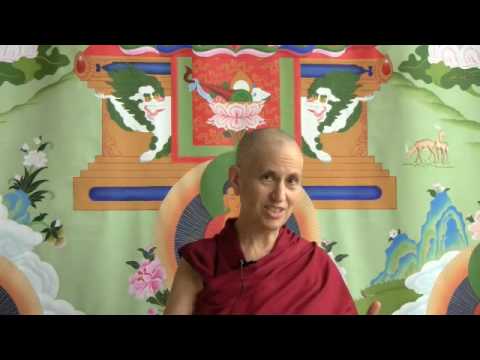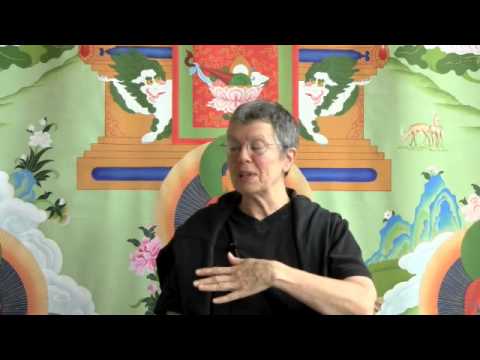Facing fears
Part of a series of Bodhisattva's Breakfast Corner talks given during the Green Tara Winter Retreat from December 2009 to March 2010.
- Anxiety and nervousness are mental states often based on fear
- Being injured or ill can stir up anxiety regarding our ability to recover
- Breathing meditation can help us to slow down the anxious, story-producing mind
Green Tara Retreat 031: Facing fears (download)
We’re talking about fear. I’m often not aware that I’m having fear. But, I am aware of certain states that fear is underneath, and so I work more with those. I was thinking about a dream that my grandma had. She was raised in Africa for her first 10 or 11 years. She was born in 1901, and there were lions and tigers there, one or the other. So for the next 60 years when she got back to the U.S., she dreamed of being chased by either a lion or a tiger. After 60 years, when she was about 70 years old, in her dream she turned around and faced it. She never had that dream again. This is the metaphor for me with fears, because when you turn around and face things, and slow your life down, and rely on insightful people that give you feedback and teachings, you can actually manage the whole thing, rather than letting it drive your life unknowingly and uselessly.
I found mainly three areas in my experience that are recurring that have to do with fear. One is related to the body, and that expresses itself mostly as a kind of anxiousness. Another is related more with other people, and that sometimes expresses itself as a kind of nervousness in some situations. Other times it would be reactivity with negative thinking as a basis. Another area was more like being stressed-out. This is the me that likes to accomplish things but then I will work way too hard. This is more the fear of me. I’ve had fear related to the body, fear related to others, and this actually goes to a place of fear related to myself—like I might just burst some day of anger because I mismanage my life for a few weeks, and I’ll just get all tangled up.
The one I know most about is the one about the body, so I thought I’d talk mostly about that. The basis of it is attachment to the body and really having enjoyed physical activity a lot. I might have even taken a rebirth on that basis, because I like to move. I dream about moving sometimes because it’s very pleasurable. So then when something comes up, like an injury, dealing with pain is one thing. But thinking about pain being permanent is quite anxiety producing. Also then dealing with possible medical interventions or losing function, those kinds of things, really sometimes I will spin out and paint worst-case scenarios in my mind. That just doesn’t work very well!
I have learned about this often from other people, especially for the things I couldn’t see about myself, for myself. I realize there are certain things that people have said to me over the decades that have helped me become more aware of these things that I couldn’t see.
The helpful thing with these types of experiences has been to listen to people who were giving me good feedback—and it’s always helpful for me to calm myself. Decades ago I used to do yoga, and that’s where I learned how to start working with this. Now I use more breathing meditation. Oftentimes in doing breathing meditation and especially if I’m having pain in that moment, I will do breathing meditation where I “gladden my mind.” Adding that “gladdening” aspect actually helps in managing the whole thing—the pain and anxiety from pain, etc.
In the short term it’s really been helpful do to breathing meditation. In the long term it’s been really helpful to just see my reactions. I’ve had all this anxiety about future loss of function, a medical intervention or whatever, and none of these things that I’ve worried about has ever come to fruition. When you get your mind calmed down enough to see that, you can then drop things. So it’s very helpful to keep a more positive outlook.
Another strategy that works really well is to just substitute [activities]. I like to do things, and maybe I can’t do what I want to do now, so I just substitute. I’ll go, “Well, I can’t do this. I will do this instead. I will enjoy this.” At one time I had an operation on my hands and I couldn’t do all kinds of things. That was the hardest aspect of the experience. So I used to go for walks and sing. I had to do something because I couldn’t do so many things when my hands were out of commission.
Venerable Thubten Tarpa
Venerable Thubten Tarpa is an American practicing in the Tibetan tradition since 2000 when she took formal refuge. She has lived at Sravasti Abbey under the guidance of Venerable Thubten Chodron since May of 2005. She was the first person to ordain at Sravasti Abbey, taking her sramanerika and sikasamana ordinations with Venerable Chodron as her preceptor in 2006. See pictures of her ordination. Her other main teachers are H.H. Jigdal Dagchen Sakya and H.E. Dagmo Kusho. She has had the good fortune to receive teachings from some of Venerable Chodron's teachers as well. Before moving to Sravasti Abbey, Venerable Tarpa (then Jan Howell) worked as a Physical Therapist/Athletic Trainer for 30 years in colleges, hospital clinics, and private practice settings. In this career she had the opportunity to help patients and teach students and colleagues, which was very rewarding. She has B.S. degrees from Michigan State and University of Washington and an M.S. degree from the University of Oregon. She coordinates the Abbey's building projects. On December 20, 2008 Ven. Tarpa traveled to Hsi Lai Temple in Hacienda Heights California receiving bhikhshuni ordination. The temple is affiliated with Taiwan's Fo Guang Shan Buddhist order.


